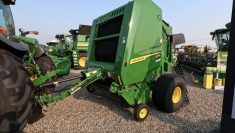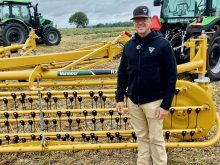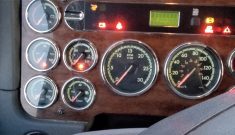Farmers earn extra cash | The tractor mounted blower can clear roads leading to hard to reach areas
BRANDON — Rapid expansion in the prairie oil patch and the gradual growth of wind farms have created a heyday for enterprising farmers.
All those access roads need to be kept drift-free.
Manufacturers representative Nick Rempel of Brandon said this results in excellent winter business opportunities for producers who have the necessary tractor power.
“When yard tractors were in the range of 100 horsepower, they didn’t have sufficient power to drive large, commercial sized snowblowers,” Rempel said.
“But it’s a different story today, with the typical mechanical front wheel assist yard tractor in the range of 180 to 280 h.p.
Read Also

Farm equipment dealership chain expands
This summer, AgWest announced it was building two new dealership buildings in Manitoba to better service its expanding market area — one in Brandon and the other in Russell.
“Snowblast makes blowers that can cut a swath 13.5 feet wide. That one requires 425 h.p. That’s the kind of tool that allows a guy to make double use of his tractor and earn some extra cash in the winter.”
More tractor power is a big factor. But there’s more to it than just power, said Snowblast sales manager Myron Holzwarth.
“GPS autosteer is the other factor making it more feasible to generate extra money with your tractor in the off season. It’s a lot easier on the operator,” he said.
“It’s simply a matter of loading the access road map into your system, just like loading a field prescription map. If you need to blow out a road in the middle of a blizzard to keep your customer happy, then that’s what you do with the GPS.”
Holzwarth said the absence of an auger is the most significant engineering factor distinguishing Snowblast from other commercial sized snowblowers.
“Augers waste energy. We don’t use augers. We have dual fans, each with its own spout,” Holzwarth said.
“In a conventional snowblower, snow goes through the augers first, then changes direction when it goes into the high speed fan. You can only drive into the snow as fast as your augers move the snow sideways. It’s not efficient. We don’t do it.”
Snow does not change direction in the Snowblast system. It is spun up to the 12 o’clock position once it hits the high-speed fan, and is then fired out the spout.
A half-moon, spiral bar with cutting teeth is mounted at the front of each fan and spins at the same speed as the fan.
A pointed spindle with four cutting blades spins at the leading point of each fan shaft. The spindle and blade are able to smash their way through any winter conditions.
“It cuts through anything. It busts up ice and compacted snow,” he said.
“The geometry of the bar deflects the snow and ice right into the fan. It’s one continuous movement, and the snow always flows in the same direction. We have guys who take these into the feedlots in the winter to blow away ice and frozen manure.”
Most snowblowers have their spouts rotating with steel against steel, which freeze down solid in slushy conditions. The ring where the spout base meets the top of the fan housing becomes a solid block of ice.
Snowblast’s spout is raised up from the fan housing and rotates on rollers that spin on bearings. Holzwarth said the gap between the spouts and fan housing ensure that freezing does not occur.
Both spouts rotate left and right together. One hydraulic cylinder is attached to the control arm that pulls the cables to position the spouts.
Holzwarth said Snowblast snowblowers are designed to withstand the kind of beating that occurs when encountering debris buried in snow banks.
Most commercial grade snowblowers have a four-blade fan, with each blade responsible for 25 percent of the load in each revolution. This increases the risk of damage and creates balance problems.
“Our minimum number of blades is six per fan. As we get larger with the blower’s size, we go up to eight blades and then nine blades,” Holzwarth said.
“Another thing that keeps our machines running is the fact that all drive chains run in an oil bath. I don’t think anyone else does that. To reduce downtime, our shear pin is located way out front at the front tip of each fan shaft. We do not put a shear pin at the p.t.o. You change the pin in three minutes, standing up without having to crawl over anything.”
Snowblasts all have replaceable adjustable skid shoes that let the blade go right down to a hard road surface or lift it up for gravel or hard surfaces.
The cutting edges at the bottom of the fan housing are bolted into place rather than welded.
Snowblast has four models:
- Eight foot with wings cuts up to nine feet, has six blades and requires 90 to 180 horsepower. List price is $14,500. It requires a category 2 or 3 hitch
- Nine foot with wings cuts up to 10 feet, eight inches, has six blades and requires 160 to 275 h.p. List price is $21,400. It requires a category 2 or 3 hitch
- Ten foot with wings cuts up to 11 feet, six inches, uses eight blades and needs 200 to 375 h.p. List price is $27,600. This is a popular model with row croppers on 30-inch row spacing because their tractors on duals are 11 feet, six inches wide. The blower can be run without changing tires for the winter. It requires a category 3 or 4 hitch
- Twelve foot with wings cuts up to 13 feet, six inches, and has nine blades, using 250 to 425 h.p. List price is $39,200. This is a popular model in the North Dakota and Montana oil patch, where farmers already own high horsepower four wheel drive tractors. It requires a category 3 or 4 hitch
Holzwarth said putting in an eight to 12 hour day in a big four-wheel drive with your head turned around backward is not the best scenario. GPS autosteer can help.
“The other thing we’re seeing in the northern states is guys buying North American built (mechanical front wheel drive) tractors, most of which can now be ordered with front p.t.o. and front three-point hitch.
“The Ford bi-directional has always been a favourite of snowblower operators. And we’ve seen front mounted p.t.o. and three-point hitches on European tractors for a number of years.
“We used to manufacture an undercarriage p.t.o., but it was never very popular. It leaves very little ground clearance, plus that tractor is now married to that snowblower.”
For farmers who have a payloader, Snowblast also builds a self-powered snowblower that attaches to the front bucket arms. With the diesel engine sitting directly behind the fan housing, there is no longer a need for a front p.t.o.
For more information, contact Nick Rempel at 204-728-7177 or visit www.teamcoinc.com.
















